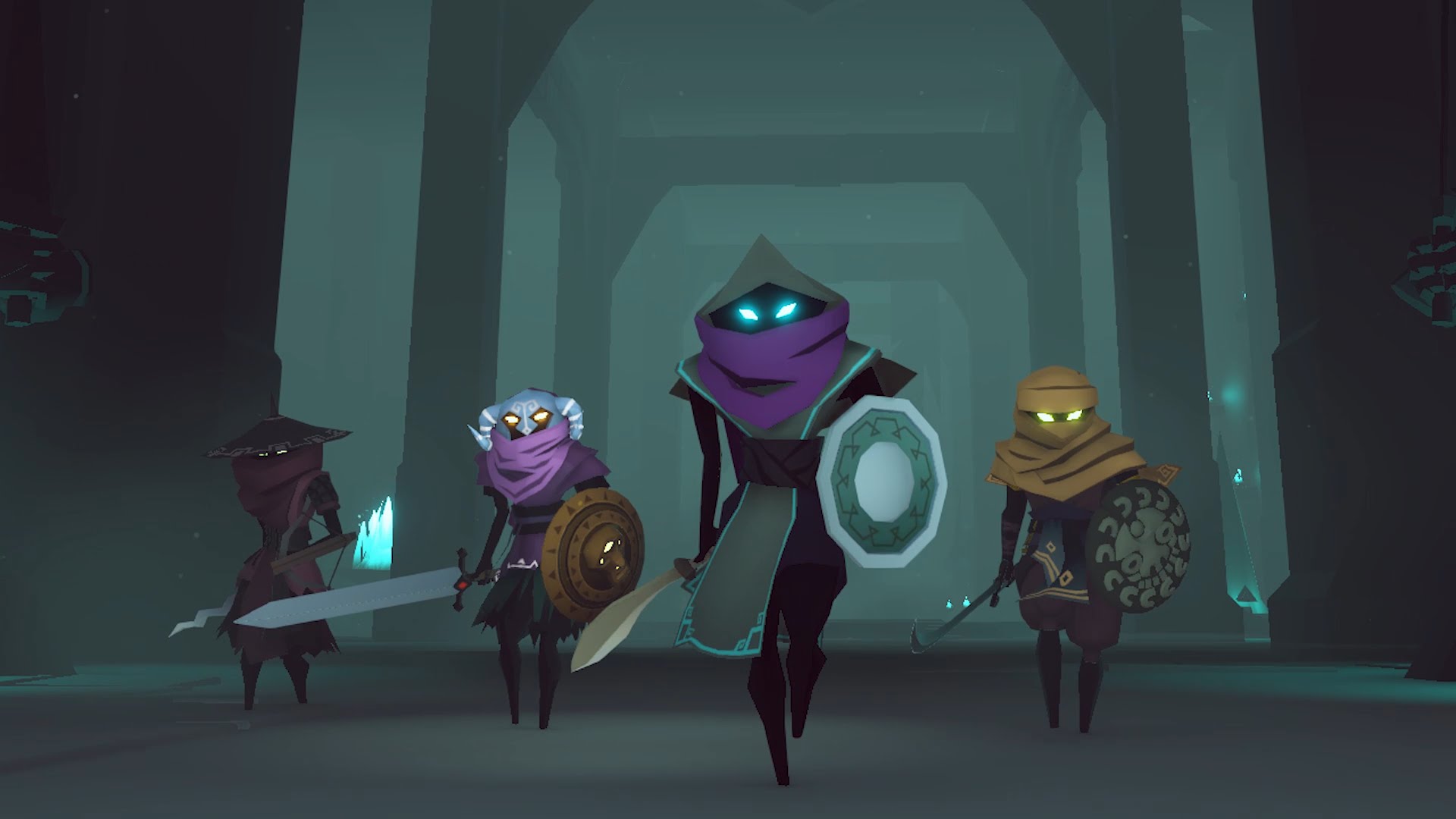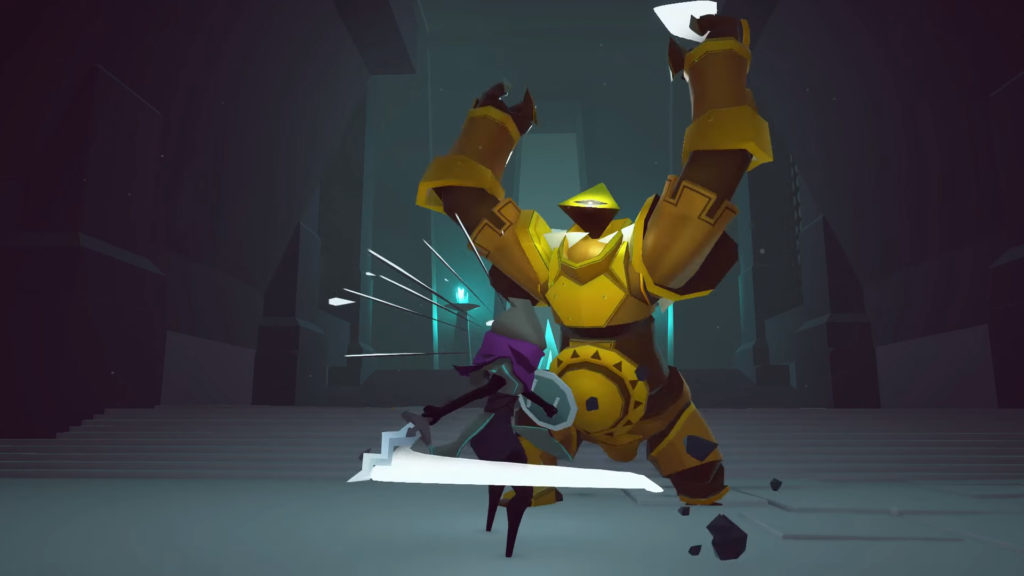Necropolis is a game of alternating frustration and boredom, with a few moments of energetic fun sneaking in on occasion. Some of the frustration in the game is intentional, but most of it is not. It is billed as a Rogue-like dungeon crawler, but the only part of that description that really fits is the “crawler” bit. This is all the more annoying because it is so close to being an excellent game within its genre, but it misses by mere inches in all the important ways.
The first thing you will notice about Necropolis is its spartan, but elegant, graphical presentation. The game foregoes detailed texturing and realistic graphics in favor of sweeping colors and simplistic character models. It should not work, but in fact it is quite striking visually and can look beautiful at times… but only at times. The rest of the time the somewhat-colorful characters are at odds with the barren locations you’ll travel through, and the world can feel extremely empty.
The lack of texturing applies to the terrain and architecture too, and it is here that the problems emerge. Long, empty halls should feel ominous and foreboding, but the lack of personality to them takes away that feeling instantly. The outdoor levels feel equally empty as if someone only bothered to put in the platforms for you to jump on, and then gave up after a while. What is even more confusing is that this game still manages to have a mildly variable frame rate, and will often freeze for a second or two while it processes something. I don’t know what is causing these drops since they seem to happen randomly with no regard for what is going on on-screen, but they are noticeable. This is not unique to the PlayStation 4 since users on the Xbox One have reported similar drops, and the PC requirements are much higher than you would expect.
The gameplay is likewise just shy of the potential it promises. Necropolis clearly draws its inspiration from action RPGs, but with a more measured and tactical approach. Combat is slow and requires careful planning, especially if you are fighting more than one enemy at a time (which is most of the time). Instead of feeling like a game of skill, though, it almost always boils down into a hit-and-run affair with lots of rolls and dodges. Even if you choose the faster of the two classes presented to you before each game you will likely only be able to get one or two hits in before having to dodge back or lift your shield. For many enemies this will have to be done several times in a single battle before you achieve victory, but they in turn only need to connect a few times to knock you out.
There are obvious parallels to a more famous game of this style, Dark Souls, but that game has a much tighter set of controls which takes much of the frustration out of the combat. In Dark Souls and its various brethren death often feels like your own fault for not being good enough, but in Necropolis I often felt unduly hampered by slow character movements and control inputs. That said, learning to master the charge attacks and target-locking system will improve your enjoyment of the combat by a massive amount. That moment when the combat system finally clicks into place is definitely one of the strong points of the game. That does not, however, make the combat system any more fun than it was initially.
The Rogue-like part of this game comes into play after you die, but the trappings of that game-type are used only minimally. Money, weapons, armor and recipes you pick up do not come with you through death. Instead you get codices, which you purchase with a separate currency earned by completing objectives. These codices give you various benefits and boosts throughout your playthrough which should help you get farther with each successive run. The trouble here is that the descriptions of them are so obtuse that figuring out what some of them do is pretty much impossible.
This is an issue not exclusive to the codex system, unfortunately. The gear you pickup have no stats or working descriptions, so trying to figure out if the sword your enemies just dropped is better or worse than the one you have now is impossible. The same goes for items, although often enough those are relatively straightforward. This is clearly a design-decision, and I am all for game companies not holding gamers’ hands and encouraging experimentation, but there’s ‘minimalist’ and then there’s ‘completely obscure’, and Necropolis falls just on the wrong side of that line. Just give us something to work with, please.
The story of the game is equally hidden behind a wall of obscurity. In fact, I really couldn’t tell you what it is. You run missions for a giant pyramid-thing at the start of the level and then you are left to your own devices. Clues are scattered about the levels, but since they are randomly generated it is entirely possible you can go entire floors without encountering anything related to the lore or story of the game. The loading screens give you the best glimpse you’ll get into the game’s world, but even there the game loses focus. Snarky narrative structures have been in vogue for the past few years with games often giving a slight wink in the direction of the player as if to acknowledge that players are becoming more aware of genre tropes as time goes on. Necropolis follows the trend, but it all feels hollow like they saw some other game winking knowingly, and tried to copy it but doesn’t actually know why it’s winking. I can’t even tell if the lore bits in the loading screens are actual lore, or if they are just meant to be poking fun of the lore of other, more popular stories.
The most frustrating thing of all is just how close to being a really good game this is. Speeding up the combat just a little bit would do wonders for the game — not to Dynasty Warriors levels, but just a little faster so it didn’t rely so much on hit-and-run tactics. Lifting the veil on the game’s plot and story would make it just that much more engaging. Lastly, adding more props to the locations in the game would make them feel lived-in and real. There is certainly something to be said for teasing out bits and pieces to players to invite them forward, but if the pieces aren’t enticing enough then no one will bother. Games like this rely heavily on the player wanting to return to the world to get just a little bit farther, to get just a little bit more loot and unravel the game’s mysteries. That doesn’t exist here, though, and the incentive to play “just one more game” never crops in. It is more fun to play in co-op (in fact, don’t even bother playing it single player, it is not worth it), but even a session with friends will eventually result in moving on to something more engaging. Sadly I cannot recommend this game, but if a sequel does crop up it might be worth a second look to see if the developers have made the needed adjustments to make a great game.

